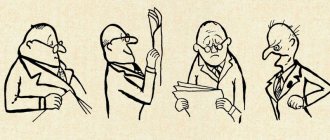- general information
- Causes
- Signs and symptoms of the disorder
- Differences between men and women
- Disorder in adolescents and children
- Tendency to drug addiction in psychopathy
- Diagnostics
- Treatment
- What will happen if left untreated?
- Complications
- Prevention
- Conclusion
Attention! Drug use causes irreparable harm to health and poses a danger to life!
The character of each person is considered an individual trait that determines the further interaction of the individual with society. With psychopathy, a disturbance occurs in the emotional-volitional sphere. Schizoid psychopathy often manifests itself in childhood. It is important to promptly pay attention to pathological symptoms and seek psychotherapeutic help.
Common features
People with a schizoid personality type are not that rare. Among them there are completely closed ones, and there are also geniuses.
Their main characteristic is isolation from the world and underdevelopment of the emotional sphere. A sign of a schizoid personality type is the versatility of emotions in the absence of their manifestation. They are often convinced that they are independent from society and treat others arrogantly. They absolutely do not know how to listen and console, sympathy is alien to them. They are often called eccentrics and strange.
Edges
The curious thing is that the boundaries themselves are arbitrary. You will never meet a face that is the canonical embodiment of a certain personality type that can be used to describe madness. Everyone will have individual characteristics and quirks. In this matter, although there are general patterns, there is a large amount of diversity.
This can be explained this way. Each person, depending on their personality type, will show exactly the deviation to which they are prone. If you imagine all this in the form of a metro map, it will look like this. As long as he is within the ring, that is, socially adapted, he is normal. But then each person will leave along his own branch.
And the branches may be different. One of them is the schizoid type. If a person is exposed to chronic stress, he will begin to regress along his branch.
At the same time, a schizoid personality can combine narcissistic, depressive traits, and so on.
Hobby
Most of all, this type of accentuation loves to read. He practically never parts with his books. Moreover, he is not an “omnivore”, preferring a certain topic. Usually he is interested in history, philosophy, and some literary genres.
Chooses unique, rarely encountered hobbies. For example, he may study Sanskrit or Chinese characters, collect information about the Rurik dynasty, or engage in calligraphy and collecting photographs of Renaissance cathedrals.
In general, as you understand, the hobbies of individuals with schizoid accentuation of character according to Lichko are usually associated with intellectual work.
Although there are situations when they play sports, despite the fact that most of the time they are clumsy. Perseverance and determination help you achieve success.
So if they decide to develop physical skills, they will not stop until they succeed in realizing their plans. They mainly do swimming, gymnastics, yoga, and running.
Causes
It is interesting that the main reason for the development of personality according to the schizoid type is psychological trauma. This may be a threat to life, lack of a sense of security. For example, during the period when man was still a fetus.
When people around a pregnant woman or she herself do not want a child, then the anger and rejection, the stress that the expectant mother experienced, affects the fetus in a negative way. Sometimes she does not intend to terminate the pregnancy, but experiences violence - moral or physical. This is one of the prerequisites for the fact that the baby subsequently begins to treat the world as a great threat.
The formation of a schizoid personality type is influenced by upbringing. If the parents were not tender and close enough with the child, communication was irregular, this provokes such a path of growing up. Schizoid personality disorder is formed in children who smooth out conflicts in the family by acting as mediators between relatives, while experiencing pain and fear from being around such people.
Constant stress on adults nearby, when they can be extremely unpredictable, also leads to such consequences. This happens when a parent is at first affectionate and then sharply hits the child, but the child does not understand why.
Overprotection also leads to the development of personality according to the schizoid type and other varieties.
When adults are alienated and impose their opinions, the child becomes schizoid. This is because you need to be more affectionate and warm with him, instilling in him confidence and a sense of security. Anyone who has not made friends with his parents looks for his intercessor in himself. This is the only way for such a child to protect his individuality from being swallowed up and crushed by someone.
Tests and diagnostics
The International Classification of Diseases, Tenth Revision, identified 9 criteria for diagnosing latent schizophrenia, and at least five of the following points must be met:
- emotional coldness and detached appearance against the background of inadequate or restrained affect;
- eccentric, eccentric and strange behavior;
- social withdrawal, poor networking skills;
- a tendency to strange judgments, suspicion and magical thinking, which can cause eccentric behavior and not correspond to subcultural norms;
- obsessive and paranoid ideas that do not cause internal resistance and are dysmorphic, sexual or aggressive in nature;
- signs of depersonalization, derealization and unusual perception may be accompanied by somatosensory (bodily) or other illusions;
- detailed, metaphorical, hyper-detailed or stereotypical type of thinking, which may manifest itself in strange pretentious speech or in another way, but is not characterized by pronounced fragmentation;
- cases of episodic transient quasi-psychotic disorders, auditory or other hallucinations, illusions, delusional ideas, which most often do not arise in response to external provocations.
In addition, it is important to study pseudoneurotic and pseudopsychopathic manifestations, assess the level of inertia, monotony, clichedness, initiative, activity, emotional coldness, mental productivity and paradoxical judgments. To do this, they also use the Diagnostic and Statistical Manual of Mental Disorders, fifth edition (DSM-5):
- pathopsychological and delusional ideas of relationships, expressed in a person’s confidence that everyone around him is negative and prejudiced;
- increased social anxiety and difficulty making friends or simply interacting with strangers;
- manifestation of “magical thinking” - superstitiousness, belief in clairvoyants, supernatural powers, telepathic abilities and a sixth sense;
- the emergence of bizarre fantasies and activities, which ultimately affects behavior and does not correspond to social norms;
- cases of bodily illusions;
- oddities of thinking and speech (statements that are vague, long, metaphorical, overly detailed or stereotypical).
A patient can be diagnosed if at least 4 of the above signs are detected and these symptoms have been observed for two or more years. In this case, the most important thing is to distinguish the schizophrenic phenotype from schizoid, delusional and paranoid personality disorder , simple schizophrenia , Asperger's syndrome and neurosis . Typically, the patient’s condition is characterized by a peculiar severity of oddities, a course of the disease similar to a personality disorder, obsessive-phobic, hysterical, depersonalization and psychopath-like symptoms.
How does formation occur?
Typically, in childhood, people with signs of a schizoid personality type are sensitive and receptive to external influences. When someone shows strong emotions, they become nervous and tense. They also react brightly to touch.
This feature persists into adulthood. As in children, a sign of the schizoid personality type in adults is sensitivity to lies. Thanks to the peculiarities of their childhood, they learned to very quickly recognize any falsehood in other people. This often causes them a lot of pain.
Therefore, people with a schizoid personality type are susceptible to stress, they run away from it into themselves, and withdraw into their own world.
This tendency can also manifest itself due to overprotection. Often a man with a schizoid personality type has a mother who violates his personal boundaries and constantly takes him to psychologists and healers during his childhood.
The situation is bad if there is a lot of insincerity and double messages in the family circle to which the child belongs. When one of the parents, not loving, behaves as if he loves, the child feels it. Often a person’s tendency to withdraw into himself arises if he is praised only in public, but is treated indifferently at home. In this way, by withdrawing into himself, he protects himself from feelings of hopelessness.
In both men and women, a schizoid personality type could develop in cases where their parents often left them alone in the crib. The children felt isolated. This happens when parents strive to raise them to be independent.
Eventually the schizoid adapts to such isolation and gives up the need for intimacy. He seeks support within himself.
There is only one conclusion: if a child is initially sensitive, and those around him place him in conditions of early isolation and loneliness, there is little empathy in the family, then a big conflict grows inside him. On the one hand, he strives for intimacy, and this is a natural need. On the other hand, he avoids her and distances himself. This is the main symptom that answers the question of how to determine the schizoid personality type.
Where does the disease begin?
Schizotypal disorder arose from schizophrenia, subsequently emerging as a separate illness. Bleuler, in addition to the vivid schizophrenic symptoms identified by Kraepelin, drew attention to milder forms of the disease, from which its primary names come: latent, sluggish, non-psychotic, sanatorium schizophrenia.
There is a close connection between the inheritance of schizotypal disorder from close relatives with schizophrenia. In this case, the risk of acquiring the disease increases significantly.
About 3% of our planet's population is affected by the disease. It occurs more often in men than in women.
The disease begins with banal apathy:
- prostration;
- increased drowsiness;
- fast fatiguability;
- lack of motivation to action;
- brokenness;
- lethargy.
Such a bouquet inevitably harms performance. First, the individual loses the desire for self-realization and interest in professional activities. He does everything through force - it costs him unimaginable emotional and intellectual effort. Broken by stress, a person loses his job.
The schizotypal person is deprived of aspirations, desires, and gives up his favorite activities. Becomes lack of initiative. It is really difficult for the patient to carry out any actions, even the most minimal ones. From the outside, such behavior is perceived as laziness. People around them can be angry with a person, encourage him to act, try to convict a schizotypal person of weak will, and call him a weakling. But everything is to no avail: the patient simply cannot work.
Asthenic disorders are accompanied by senesthesia and senestopathy. Senesthesia refers to non-standard sensations in the motor sphere that are difficult to interpret. The sufferer is observed to have an unnatural gait: swaying from side to side, legs tangling. Hands hang like whips, head drooping.
Senestopathies are unpleasant, indescribable sensations in the body. The patient draws them artistically:
- feet burn with fire;
- the head is boiling like in a frying pan;
- It’s hard to breathe, as if your throat is being squeezed in a vice.
When unusual sensations appear, physical pathologies are excluded.
Apathetic disorders contribute to the development of gentle behavior. In order not to waste energy, the schizotypal person gets rid of unnecessary actions. Gradually he adapts to a limited life, albeit at a lower social and professional level.
Another category of patients, on the contrary, exhibits overcompensation, finds an absorbing hobby, and plays sports to the point of exhaustion. Still others resort to drugs and alcohol. Everyone is looking for their own way of adaptation.
When pathological changes grossly change personality, a person becomes maladapted in society. In this case, he loses the ability for minimal productive functioning, even to the point of disability.
At school
Everything remains the same. He is again solitary and does not really strive to get in touch with his surroundings or make friends. He has high self-esteem and does not take into account the opinions of others. Usually he likes to talk about intellectual topics, devoid of emotions. He has a special ability for mathematics or writing. Sometimes it is noticeable that he is very erudite.
One thing he doesn’t do so well is that a child with a schizoid personality type does not understand how to communicate with people. He himself sees that he is having difficulty establishing contacts. For this reason, he does not like to go for walks. He never shows violent emotions - neither joy, nor sadness, nor anger. When communicating with a schizoid, it is extremely difficult to figure out how he relates to external stimuli.
Parents may worry about his coldness if they themselves do not have the same personality type. Such children do not kiss, do not hug their relatives, and cannot bear affection addressed to them.
Most often, this character and lack of communication skills lead to conflicts with peers. Schizoids often become outcasts. They are unable to stand up for themselves and take advantage of manipulation. They are unlikely to become leaders in the future.
Prevention
Families who have previously had cases of schizophrenia in their family should especially think about preventive activities in matters of schizoid personality disorder. The main condition is to reduce the number of stress factors that have a negative impact on the developing psyche of the child. It is important to teach a teenager the correct emotional response to the reactions and influences of the social environment.
The difficult but necessary task of parents is to accustom their child to the correct work and rest schedule and explain the value of a healthy diet. A culture of relaxation is important. Ideally, during adolescence, a child develops the habit of reading before bed. It will be great if he learns to prioritize listening to relaxing music over playing computer games and watching blockbusters. Preventing the recurrence of the disease is an equally important task in the compensation phase of the disease. It is important to prevent personal disharmony and a decrease in the degree of social adaptation.
“If you find out that your loved one or relative is schizoid, try to translate all your arguments into terms of reason, do not overload with emotional manifestations. Remember that there is always an internal logic in the decisions of such a person, even if his action seems strange. It is not so easy to understand, but if you figure it out, the person will become quite predictable for you. It’s not necessary to guess; you can simply ask why your friend acted this way and not otherwise,” Pavel Beschastnov, psychiatrist and psychotherapist.
If a person, regardless of the treatment and rehabilitation therapy completed, still resumes the usual reactions: increased anxiety, deception of perception reappear, thinking is disorganized, it is necessary to consult a doctor. A psychiatrist will prescribe antipsychotic drugs and thereby prevent the disorder from transforming into a deeper mental disorder. Severe forms of psychosis will be excluded. The person will become normal again and will not interfere with the lives of others.
Teenage years
The most difficult stage for children seeking solitude is their teenage years. They are intellectually superior to their classmates. But they constantly experience rejection and are deprived of normal relationships with them. Their self-esteem goes up and down. The child is either proud of his intellectual abilities, or falls into self-flagellation. When his parents invade his inner world, he protests.
A schizoid gets irritated by many things: someday someone enters his room without knocking, touches his things, controls his studies and shows interest in his life. Usually he is not burdened by loneliness, but solitude always attracts the attention of his classmates. Such children can play sports, but they strive not for team sports, but for individual sports.
How to communicate
The best solution would be to communicate with a schizoid on intellectual topics and instill communication skills. So, it’s worth starting with psychology and talking about the forms of relationships between people. This should not be intrusive, but the main thing is for the child to understand: relationships with people can be very interesting to him in themselves. Then you can invite guests to the house, take him with you on a visit. But under no circumstances should you socialize by force. This will cause him even more rejection either towards people or towards himself. The key here is to awaken his interest.
Adults
Having matured, a person has already established character traits, full of contradictions. On the outside he looks absolutely calm, but on the inside he has a storm of emotions. Even a small detail can provoke a real tsunami inside him, but hardly anyone around him will guess about it, while significant events can cause complete sincere indifference in him.
He has an ambiguous relationship with himself. He sees that he has high intellectual potential, which instills in him pride and self-confidence, and sometimes contempt for others. But his self-esteem is greatly affected by the inability to start relationships, to engage in activities that are in one way or another connected with other people.
His behavior reveals a lack of understanding of how to behave in the most trivial situation. When his interlocutor shows hostility to him, he may not be aware of it. His intuition is undeveloped, so it is very difficult for him to defend himself against ill-wishers. And even if they show sympathy and love to him, he will not notice it until the moment he is told about it. Communication with others for schizoids is Chinese literacy, which they do not understand how to master.
They show their aversion to communication in different ways: they can be timid and shy, or they can be rude and ironic. Sometimes they show cruelty in order to leave them alone. Their character contains the following traits: pliability and stubbornness, vulnerability and coldness.
They may well fall in love at first sight. But in personal relationships they show indifference to children and cheat.
Outwardly, people with a schizoid personality type look eccentric. They have angular movements, a strange gait, behavior, everything looks unnatural. They are often thin and with their shoulders raised to their ears, their head pressed into their shoulders. They ignore fashion, not taking into account the opinions of others about how they look.
University
→ Home → University → University in the media → 13 psychotypes of personality: from paranoid to cycloid
They say there is a scale of psychotypes. How can you find out how your own child is growing up in order to help him fight his negative traits? Zinaida K., Gomel.
The classification of accentuations was developed by the German psychiatrist Karl Leonhard in 1968. Based on his works and the research of Russian psychiatrist Pyotr Gannushkin, Soviet psychiatrist, Honored Scientist Andrei Lichko created his own personality typology.
PARANOID
Traits of this psychotype rarely appear in childhood; the guys are focused on one thing, serious, preoccupied, striving to achieve what they want at any cost.
Dominant character trait: high degree of determination. Such teenagers subordinate their lives to achieving a goal (quite large-scale), while being able to neglect the interests of others. They are ready to sacrifice well-being, give up entertainment, comfort and other joys common to children.
Attractive character traits: high energy; independence; independence; reliability in cooperation when goals coincide with the aspirations of the people with whom they work.
Repulsive traits: irritability, anger, if something or someone gets in the way of the goal; weak sensitivity to other people's grief; authoritarianism.
The “weak link” of the psychotype: they are extremely ambitious in the grand scheme of things, not in small things.
Features of communication and friendship. When making contact, they often suppress their interlocutor, are overly categorical in their judgments, and can hurt others with their words. They don’t notice their own conflict. Completely unsentimental, friendship is viewed as a continuation of a common great cause. Friends are only comrades.
Attitude to study and work. Only those subjects that are needed now or will be needed in the future are carefully studied. To do this, they can go to the library, take extra classes, buy a lot of books, and read during breaks. And everything else in school is of no value. The greatest success is achieved in individual creative work. Unsurpassed generators of big ideas and non-standard approaches to solving complex problems. EPILEPTIOID From preschool age, children predisposed to this type are thrifty with clothes and toys. They react sharply to those who try to take possession of their property; From the first school years they show increased accuracy.
Dominant character traits: love of order, desire to maintain what has already been established, conservatism; high energy (students willingly engage in physical education, run, speak loudly, organize everyone around them, and with their activity often disturb others). In extreme situations, teenagers become brave and even reckless; in everyday life they show anger, explosiveness, and pickiness.
Attractive character traits: thoroughness, accuracy, diligence, frugality (often turning into pedantry), reliability (always keep promises), punctuality (in order not to be late, they will set 2 alarm clocks and also ask their parents to wake them up), attentiveness to health.
Repulsive character traits: insensitivity to the grief of others, excessive irritability due to noticed disorder, carelessness of others, or violation of rules.
The “weak link” of the psychotype: they cannot tolerate disobedience and violently rebel against infringement of their own interests.
Features of communication and friendship. They do not make casual acquaintances; they prefer to communicate with childhood friends and schoolmates. If they consider someone a friend, then they fulfill all the obligations that friendship imposes. Betrayal, either in friendship or in love, will never be forgiven.
Attitude to study and work. They are goal-oriented, complete all homework, do not skip classes, and are usually excellent students. Growing up, they perform best in work related to maintaining order, rules and regulations adopted by someone else (for example, a financier, lawyer, teacher, military man, etc.). HYPERTIME Those belonging to this psychotype have been distinguished since childhood by their noisiness, sociability, and courage; prone to mischief. They lack a sense of distance in relationships with adults.
Dominant character traits: high spirits, extroversion, joy from communication, good health and blooming appearance.
Attractive character traits: energy, optimism, generosity, desire to help people, initiative, talkativeness, cheerfulness; the mood is almost independent of what is happening around.
Repulsive character traits: superficiality, inability to concentrate on a specific task or thought, constant desire to do something more interesting at the moment, jumping from one thing to another (such guys sign up for several clubs or sections at once, but none for longer than 1– They haven’t walked for 2 months), disorganization, familiarity, frivolity, readiness to take unrestrained risks.
The “weak link” of the psychotype: cannot tolerate a monotonous environment, monotonous work that requires painstakingness or a sharp limitation of communication; they are oppressed by loneliness and forced idleness.
Features of communication and friendship. They always act as merry fellows and jokers. Their home is a meeting place for friends and acquaintances, where anyone can come and stay as long as they like. They are always drawn to the company and strive for leadership among their peers. They can easily find themselves in an unfavorable environment and are prone to adventures. They are not capable of deep affection. They are characterized by love for their neighbor (and not for all humanity); rush to help without hesitation. In friendship they are kind and unforgiving. Having offended someone, they quickly forget about it and will be sincerely happy the next time they meet; if necessary, they will apologize for the offense caused and do something nice.
Attitude to study and work. Schoolchildren of this psychotype would achieve significant success if they were not so frivolous and could concentrate on one subject. All subjects are easy for them, but the knowledge they receive at school is superficial and often unsystematic. They are constantly late for classes and skip classes (especially those classes in which they are bored and have no opportunity to express themselves). It’s easy to catch up on lost time: for example, before a test or exam, they don’t sleep for one night and learn almost everything.
Capable of achieving success in any business. At first, everything goes well for them, achievements appear, but if routine work begins, it becomes uninteresting, the activity ceases to be new, then they are ready to quit at the first opportunity and switch to something else.
Noisy and overactive, they often create the appearance of productive activity (they willingly and eagerly get down to business, plan a lot of events, hold meetings, etc.), which helps to advance their career.1
HYSTEROID
This psychotype is visible from early childhood. A cute baby, in front of a large number of adult strangers, recites poems, sings songs, and demonstrates his talents and outfits without any embarrassment. The main thing for him is admiring spectators. If guests sat down at the table and forgot about it, it will certainly attract attention again. If unsuccessful, he will knock over a glass on the tablecloth or break a saucer.
Dominant character traits: demonstrativeness; the desire to constantly be the center of attention, sometimes at any cost; thirst for constant admiration or surprise, veneration, worship.
Attractive character traits: perseverance, initiative, sociability, dedication, resourcefulness, activity, pronounced organizational skills, independence and willingness to take leadership (although after a burst of energy, the listed qualities quickly fizzle out).
Repulsive character traits: a tendency to intrigue and demagoguery, hypocrisy, cockiness, recklessness, thoughtless risks (but only in the presence of spectators), boasting about non-existent successes, taking into account only one’s own desires, inflated self-esteem, touchiness.
The “weak link” of the psychotype: inability to withstand blows to egocentrism, exposure of fictions.
Features of communication and friendship. They constantly need numerous viewers. In principle, this is the main form of their life (in public and for people). But, as a rule, they communicate only with those who express their admiration and idolize their abilities and talent. Very often they are selective, striving to be friends with famous people in order to be in the shadow of their fame, or with those who lose to them in order to shade themselves even more.
Attitude to study and work. Often this is just a reason for communication, an opportunity to express yourself among people. They go to school for fun. To attract attention, they study not just well, but better than anyone else, surprising teachers with their abilities in various subjects. In principle, these are gifted, talented people who are easily given professions related to artistic creativity. They work best outside the team and outside the mandatory framework. SCHIZOID Since school years, such children like to play alone, are not drawn to classmates, avoid noisy fun, preferring the company of older children. In adolescence, isolation and isolation, and an inability to empathize with others are striking.
Dominant character trait: introversion. This is a pronounced mental type, constantly analyzing the surrounding reality.
Attractive character traits: seriousness, restlessness, taciturnity, stability of interests and constancy of activities. As a rule, these are talented, smart and unpretentious schoolchildren. Productive, they can work on their ideas for a long time, but do not push through them, do not implement them.
Repulsive character traits: isolation, coldness, rationality. Such children have low energy and are inactive during intensive work - both physical and intellectual. Emotionally cold. Their egoism is unconscious. At the same time, they are vulnerable, because they are proud. They do not tolerate criticism of their system.
The “weak link” of the psychotype: they cannot tolerate situations in which it is necessary to establish informal emotional contacts, and the violent invasion of strangers into their inner world.
Features of communication and friendship. Very selective; people are hardly noticed, like many things in the material world. But they still need communication that is deep and meaningful. The circle of people with whom they come into contact is limited (as a rule, they are older). They are characterized by self-sufficiency in the sphere of relationships; they can communicate with themselves or with one person. A friend is one who understands their characteristics well and does not pay attention to oddities, isolation and other negative character traits.
Attitude to study and work. They are capable and talented, but require an individual approach, since they have a special vision of the world, their own point of view on ordinary phenomena and objects, unlike others. They know how to study a lot, but not systematically, because it is difficult to fulfill generally accepted requirements, and not according to the scheme they themselves invented. When they see that a teacher evaluates the result of work, and not formal compliance with mandatory rules, they show all their talent. If the teacher and parents require children of this psychotype to solve problems in a strictly defined way (as explained in class), then they will fall behind, despite the fact that they are quite capable of solving the same problems in several original ways. This applies not only to mathematics, but also to other academic subjects. Most often, such guys make excellent scientists, for example mathematicians or theoretical physicists. PSYCHASTENOID Along with some timidity and timidity, such children have a tendency to reason and have intellectual interests that are beyond their age. From a young age they suffer from various phobias - fear of strangers, new objects, darkness, being alone at home, etc.
Dominant character traits: uncertainty and anxious suspiciousness, fear for one’s future and loved ones.
Attractive character traits: accuracy, seriousness, conscientiousness, prudence, self-criticism, even mood, loyalty to promises, reliability.
Repulsive character traits: indecisiveness, a certain formalism, a tendency to long discussions, self-examination. There may be fears regarding an unlikely future, based on the principle “no matter what happens” (hence the belief in omens). Another form of protection against constant fears is conscious formalism and pedantry, which are based on the idea that if everything is carefully thought out in advance, foreseen and then acted without deviating a single step from the planned plan, then troubles can be avoided. Such teenagers find it difficult to make decisions; they constantly doubt: have they taken everything into account? But if they dare, they begin to act immediately, because they are afraid that they will change their mind.
The “weak link” of the psychotype: fear of responsibility.
Features of communication and friendship. They are shy, self-conscious, and do not like to make new contacts. They have few friends, but this friendship lasts forever. They remember the smallest details of the relationship and are sincerely grateful for your attention.
Attitude to study and work. They are able to study without raising their heads, showing determination, perseverance and perseverance for a long time, because they are afraid of upsetting their loved ones and teachers with low grades. The result obtained is checked against reference books, dictionaries, and encyclopedias; They'll call a friend and ask him.
These are ideal subordinates: they will complete any work carefully, accurately and on time, if the task is specific and there are instructions clearly regulating the procedure for its implementation. Such people like a quiet profession, for example, a librarian, accountant, or laboratory assistant. SENSITIVE From the first steps, these guys are fearful, afraid of loneliness, darkness, animals, especially dogs. They avoid active and noisy peers, but are sociable with those they are accustomed to; They love to play with kids: they feel confident and calm. They are very attached to their family and friends, these are “home children”: they try not to leave their native walls, they do not like to visit, much less travel somewhere far away (for example, to another city, even if their beloved grandmother lives there).
Dominant character traits: increased sensitivity, impressionability. Children are timid and shy, especially among strangers and in unusual surroundings. They see many shortcomings in themselves.
Attractive character traits: kindness, calmness, attentiveness to people, a sense of duty, high internal discipline, responsibility, conscientiousness, self-criticism, increased demands on oneself. They strive to overcome their weaknesses.
Repulsive character traits: suspiciousness, fearfulness, isolation, a tendency to self-flagellation and self-humiliation, confusion in difficult situations, increased sensitivity and conflict on this basis.
The “weak link” of the psychotype: they cannot tolerate ridicule or suspicion from others of unseemly actions or unkind attitudes.
Features of communication and friendship. They contact with a narrow circle of people who arouse their sympathy. They avoid meeting and communicating with the lively and restless in every possible way. They prefer to share experiences and sensations with old friends.
Attitude to study and work. They study because they do not want to upset their relatives and teachers. They are embarrassed to answer at the board, they are afraid that they will be called an upstart. With a friendly attitude from teachers, they show excellent results. For them, work is something secondary; the main thing is warm and kind relationships with colleagues and the support of their manager. They can be executive and devoted secretaries, assistants, etc. HYPOTHYMOUS They do not show much joy, they are offended by everyone, especially by their parents. There is an expression of dissatisfaction on their faces, frustration because they did not do it the way they wanted.
Dominant character trait: always in a minor key.
Attractive character traits: conscientiousness, keen critical view of the world. They strive to be at home more often, to create comfort and warmth, thereby avoiding unnecessary worries.
Repulsive character traits: touchiness, vulnerability, despondency, tendency to look for illness in oneself, almost no interests and hobbies. Fast fatiguability.
The “weak link” of the psychotype: open disagreement with a different perception of reality.
Features of communication and friendship. Often and for a long time they are offended by others and friends, although they urgently need communication, so that they have someone to complain about life, about the fact that they were not understood or appreciated. I like to talk about the difficult circumstances in which I found myself. The advice of your interlocutor will be answered with a lot of arguments why nothing can be changed and it will only get worse.
It is difficult to be friends with such children: they see in any person a possible reason for the deterioration of their mood.
Attitude to study and work. They prove themselves by memorizing the material well and carefully completing assignments, but they are not particularly interested in the depth and content itself. They study for fear of a bad grade. Citing illness, they may skip classes, most often in physical education, labor training and other subjects, the teachers of which do not make allowances for a bad mood.
It happens that they complain about people, circumstances, and ask to be given another task. But everything repeats itself: shortcomings, negative aspects in the organization of production or traits in others - a whole uprising in the soul. It's hard to do one thing all the time.
CONFORMAL TYPE
This type is quite common. Children agree with everything that their immediate environment suggests, but as soon as they come under the influence of another group, they change their attitude towards the same things to the opposite. They lose their personal attitude towards the world - judgments and assessments will coincide with the opinions of those with whom they communicate at the moment. Moreover, they do not stand out, do not impose their opinions, representing the masses who agree with the leader.
Dominant character traits: excessive adaptability to the environment, almost complete dependence on family and company. Life flows under the motto: “Think like everyone else, do like everyone else, and so that everything is like everyone else.” This extends to clothing style, behavior, and views on important issues. These teenagers become attached to their peer group and unconditionally accept its value system without criticism.
Attractive character traits: friendliness, diligence, discipline, flexibility. They will not be a source of conflict or discord. They listen to the guys’ stories about “exploits”, agree with proposals from leaders, willingly participate in “adventures”, but then they can repent. They lack their own courage and determination. If the micro-team seems significant and has a positive orientation, then together with it they can achieve serious success, for example, by studying in some section.
Repulsive character traits: lack of independence, almost complete lack of criticism towards oneself and the immediate environment.
The “weak link” of the psychotype: they cannot tolerate drastic changes or breaking the life stereotype.
Features of communication and friendship. They easily establish contacts with people and at the same time imitate leaders. Friendly relationships are fickle and depend on the current situation. They do not strive to excel among friends and do not show interest in making new acquaintances.
Attitude to study and work. If everyone around them studies well, then they will make an effort to keep up with their friends. The attitude towards work also depends on the mood of the team; are able to demonstrate diligence, diligence, creativity and ingenuity, and carry out everything that is assigned. Or they may shirk or do work formally if there are slackers nearby.
UNSTABLE TYPE Since childhood, they are disobedient, restless, climb everywhere, but at the same time they are afraid of punishment and easily obey their peers.
Dominant character traits: complete inconstancy of manifestations, dependence on any person who is nearby at that moment. Easily influenced.
Attractive character traits: sociability, openness, helpfulness, goodwill, speed of switching in business and communication. Often, outwardly, such teenagers are obedient, ready to fulfill the requests of adults, but their desires quickly disappear; very soon they forget about their word or are lazy, they come up with a lot of reasons why they cannot do what they promised.
Repulsive character traits: craving for empty pastime and entertainment, talkativeness, agreement, irresponsibility.
The “weak link” of the psychotype: neglect, lack of control.
Features of communication and friendship. Non-conflicting. Their contacts are pointless. They can be part of several groups at once, adopting the rules and style of behavior of each team. Tend to live for today; They sit for hours in front of the TV, listening to music. They act as assistants to leaders.
Attitude to study and work. Under the influence of another hobby, they may begin to study well or abandon their studies, which will inevitably lead to large gaps in knowledge. Further studies become more difficult. Their knowledge is unsystematic, their attention is unstable, and during lessons they are often distracted from work for a long time. Homework is done reluctantly. Such people do not make good specialists. ASTHENIC Since childhood, poor sleep, poor appetite, often capricious, afraid of everything. Sensitive to loud sounds, bright light; they quickly tire of even a small number of people; strive for solitude.
Dominant character traits: increased fatigue, irritability.
Attractive character traits: neatness, discipline, modesty, complaisance, diligence, friendliness, forgivingness.
Repulsive character traits: capriciousness, self-doubt, lethargy, forgetfulness. Such teenagers are timid, shy, have low self-esteem, and cannot stand up for themselves. They experience great anxiety when external circumstances change and stereotypes are broken, because their psychological defense mechanism is getting used to things and their way of life.
The “weak link” of the psychotype: sudden affective outbursts due to severe fatigue and irritability.
Features of communication and friendship. They do not strive for close relationships due to uncertainty and do not show initiative. The circle of friends is limited.
Attitude to study and work. Low self-esteem often gets in the way. Constant doubts, feelings of anxiety and fear of making a mistake prevent you from working normally in class or answering at the board, even when the material has been learned. Work is tiring and does not bring joy or relief. Heavy and tense causes irritation. They need periodic rest or alternation of different types of activities.
LABILE TYPE They often catch colds. They are capable of getting upset because of an unflattering word, an unfriendly look, or a broken toy. Pleasant words, a new suit or book, good news quickly lift your spirits and give a cheerful tone to the conversation, but at any moment another “trouble” can change everything.
Dominant character trait: extreme mood swings from insignificant reasons. The state of mind determines everything: appetite, sleep, general well-being, desire to communicate, learn, performance.
Attractive character traits: good nature, sensitivity, affection, sincerity, responsiveness (during periods of high spirits). Loyalty to those with whom you are on good terms, who are loved and cared for. Moreover, this attachment remains, even if the mood has changed.
Repulsive character traits: irritability, short temper, pugnacity, weakened self-control. During a normal conversation, they can flare up and say something impudent and offensive.
The “weak link” of the psychotype: emotional rejection of significant people, loss of loved ones or separation from those to whom they are attached.
Features of communication and friendship. It all depends on my mood. If you are happy and satisfied with life, then you establish contacts with great desire; if you are upset and not satisfied, then they are minimal. They have developed intuition and easily determine a “good” and a “bad” person when choosing a friend. They prefer to be friends with those who, during periods of low mood, know how to distract, console, tell something interesting, protect in the face of attacks from others, and, in moments of emotional upsurge, share wild joy and fun. Capable of loyal friendship.
Attitude to study and work. Characterized by extreme variability; They react unpredictably to remarks and requests from the teacher or parents: in response to a remark they are able to laugh and joyfully begin to correct the mistake, but tears, irritation, and reluctance to obey the legitimate demands of the teacher are quite possible. Knowledge is superficial and unsystematic, because such teenagers do not manage themselves and cannot be controlled by adults. They switch gears, forget about their bad mood, if the work interests them, doesn’t get boring, and captivates them. CYCLOID These schoolchildren are no different from their peers, but from time to time they are unusually noisy, mischievous, and are constantly doing something. Then they become calm and controlled again. Adolescents experience periodic phases of mood swings, the duration of which ranges from several days to a week or more.
Dominant character trait: cyclical changes in the emotional background (high mood disappears, emotional decline puzzles everyone).
Attractive character traits: initiative, cheerfulness, sociability, when your soul is good.
Repulsive character traits: inconsistency, imbalance, indifference, outbursts of irritability, excessive touchiness and pickiness towards others. If you are overcome by sadness, then everything falls out of your hands; What was easy yesterday requires incredible effort today. During a recession, it is more difficult to live, study, and communicate. Companies are annoying, risk, adventure, entertainment are losing their appeal. They become “homebodies” for a while.
Mistakes and minor troubles are very difficult to experience on pessimistic days. Just yesterday they won the tournament, but today the game isn’t going well, the coach is unhappy... It’s depressing, they don’t recognize their body, they don’t understand their irritation, they don’t want to see their loved ones. They respond to remarks and remarks with dissatisfaction, although deep down they are very worried about these sudden changes. There is no feeling of hopelessness; they are confident that after some time everything will be fine again. You just need to survive the recession period.
The “weak link” of the psychotype: emotional rejection by significant people, a radical break in life stereotypes.
Features of communication and friendship. Relationships with people are cyclical: the craving for communication, new acquaintances, reckless prowess are replaced by isolation, reluctance to talk even with parents and close friends (“I’m so tired of you all”). They are truly friends with those who understand this inevitability of change in relationships and are not offended and forgive outbursts of irritability and resentment.
Attitude to study and work. Periods of active work in the classroom and at home are followed by stages when complete indifference to anything sets in. In work, everything works out and works out as long as it’s interesting; as soon as the mood drops, they are dissatisfied with everything that is offered to them.
Based on the degree of severity, we can distinguish 2 types of character accentuations, which is necessary to know for an individual approach in raising a child, when choosing career guidance, forms of personal and family psychotherapy: • obvious accentuation - an extreme variant of the norm. Character traits are expressed throughout life; • hidden accentuation is a common variant of the norm. Some special character traits appear mainly during psychotrauma.+
These 2 types can transform into each other, which is influenced by family upbringing, social environment, professional activity, and physical health. In contrast to “pure” types, mixed forms of character accentuation are much more common. Natalya Grigorieva, Associate Professor of the Department of Psychiatry and Medical Psychology of BSMU, Candidate of Medical Sciences. Sciences Medical Bulletin , July 31, 2014
Share
Schizoid paranoid personality type
There are never pure types, so a schizoid may have paranoid traits. In this case, his tendency to suspicion is more clearly expressed. He strives to strike first before the blow he imagines. Most often, it is the paranoid who find themselves in a situation where they are being watched or persecuted. This is all due to the fact that their character attracts this kind of trouble.
Children growing up with paranoid traits have had their sense of self-worth violated. They may feel overwhelmed by criticism and unfair punishments.
Often, parents who strive to raise a child using harsh methods raise a paranoid child.
However, these traits are also passed on from parents. When the mother herself needs consolation and therefore cannot accept the children’s fears and anxieties, they reject the anxiety so as not to feel it. But anxiety does not go away, but goes out into the outside world in this way. “I hit the furniture” will become “The furniture hit me!” Evil furniture! This leads to the formation of a paranoid personality type, living in fear and expectation of harm from strangers. A person will always monitor his relationships with them with special vigilance.
Within normal limits, paranoia manifests itself in the belief that some members of society are dangerous to humans - terrorists, racists, which is quite justified. But the fact that paranoiacs are preoccupied with this shows a certain obsession with this idea.
A big step in realizing your own paranoia is recognizing that a person attributes non-existent traits to others.
Sensitive-schizoid personality type
These types of people are sensitive and impressionable. They place high demands on themselves and suffer from low self-esteem, timidity and shyness. When they encounter troubles, they show caution, suspicion, and withdraw into themselves. Dress with taste. Their faces bear the imprint of good nature and attentiveness. They monitor the reactions of others very sensitively.
They are distinguished by their diligence and devotion, they have a penchant for kindness, and they are sociable. It is important for them to be recognized in society. Interests relate to the intellectual sphere. From a young age, they tend to avoid adventures and risky activities. But they are critical of themselves, and therefore they strive to compensate for a lot in themselves. They try to behave more cheekily and boldly. But the slightest manifestation of sympathy for them makes them burst into tears, indicating a deeply felt internal conflict. The leadership role is difficult for them.
Therapy
Only a psychiatrist knows how to treat a schizoid personality type. Neither psychotherapists nor psychologists can make a diagnosis. Common tests for schizoid personality type do not help either. The whole point is that a person can perceive himself completely differently than he really is, and this is a common situation. Specific medical tests for the schizoid personality type - Rorschach, TAT - only help in making a diagnosis. The psychiatrist relies on the patient's entire life history to accurately classify him as a particular personality type.
Patients often suffer from anxiety and depression. Their ability to communicate and build relationships is poorly developed. If therapy is absent, they have even more difficulty in social situations and this leads to isolation.
Therapy involves long-term work with a psychotherapist who has extensive experience interacting with such people.
Some psychotherapeutic methods have proven extremely effective in treating schizoid personality disorder. These consultations make it easier for the patient to interact in society, and he forms close relationships with the environment. He is taught the necessary social skills that lead to him feeling comfortable in communication.
Cognitive behavioral therapy methods help to get rid of eccentric and socially undesirable actions. They also help identify harmful thoughts in your head and replace them with positive ones.
The impact of family therapy on schizoids who live with someone is very useful. This helps strengthen relationships between loved ones.
Sometimes, along with psychotherapy, medications are prescribed that relieve anxiety and relieve depression. There is no medication specifically designed for this personality type, but antidepressants relieve a number of symptoms that schizoid people experience.
There are currently no known ways to prevent schizoid personality disorder. But if you diagnose it early and treat individual manifestations, then the person adapts to society and feels comfortable being in it.
Classification
Based on clinical manifestations and available diagnostic data, schizotypal disorder is divided into 6 types and is called:
- Latent schizophrenia , that is, a prepsychotic or prodormal degree of development of schizophrenia, for which psychotic symptoms are not characteristic, but only mild psychopathological manifestations (ICD-10 code: F21.1.).
- Neurosis-like or pseudoneurotic schizophrenia - when the patient’s condition is dominated by psychopathological symptoms resembling neurotic ones, including depersonalization, phobias , obsession, subdepression and hypochondria (ICD-10 code: F21.3.).
- Pseudopsychopathic or psychopathic schizophrenia , including borderline states of patients with schizophrenia, are usually accompanied by character changes and various behavioral disorders (ICD-10 code: F21.4.).
- Poor symptoms or simple sluggish schizophrenia is a type of schizotypal mental disorder, as in primary defect psychosis , negative symptoms most often predominate: apathy , asthenic defect, narrowed or flattened affect, social withdrawal, however, without episodes of delusions or hallucinations (ICD-10 code: F21.5.).
- Schizophrenic reaction - a reactive, psychogenically caused psychotic reaction with signs of schizophrenia (ICD-10 code: F21.2.).
- Unspecified schizotypal psychopathy - if data collection, observation and psychoanalysis do not provide a complete picture - the diagnosis may be labeled “NOS” - without additional instructions (ICD-10 code: F21.9.).











